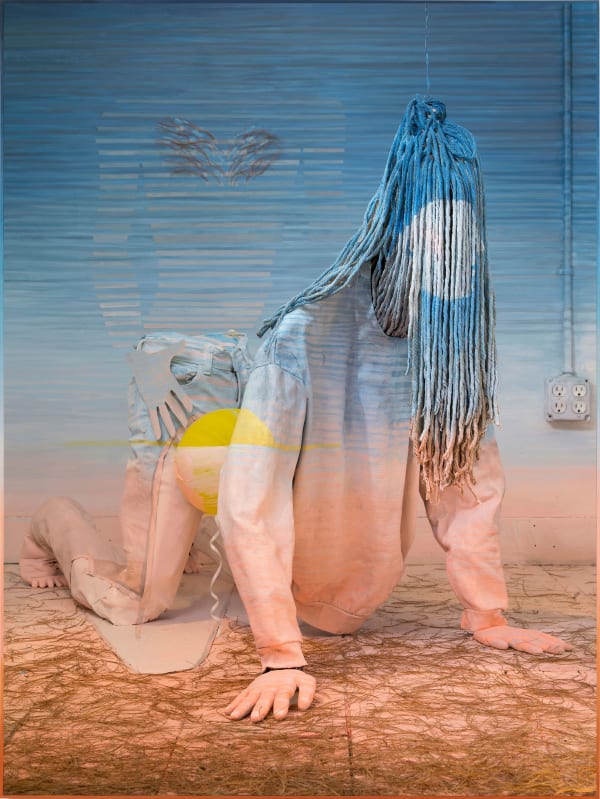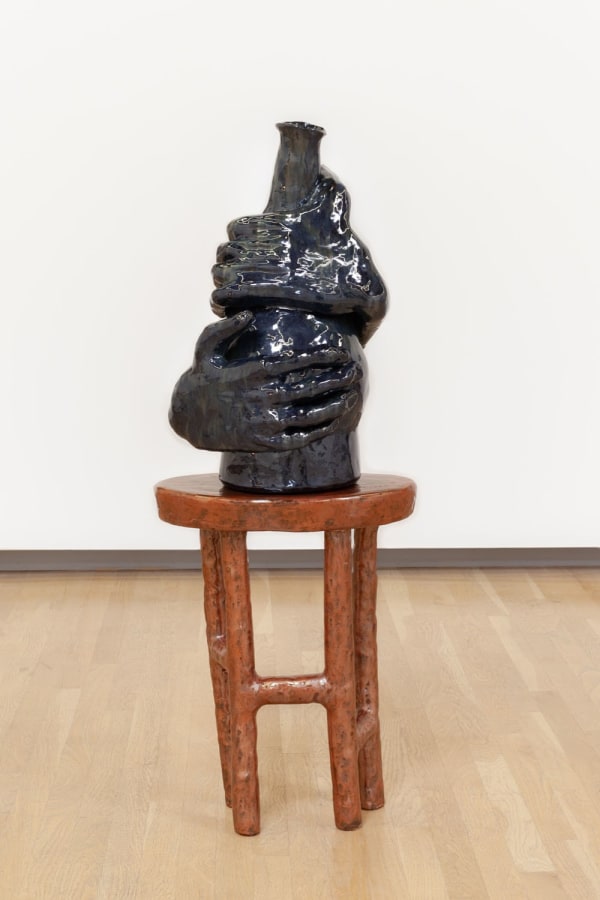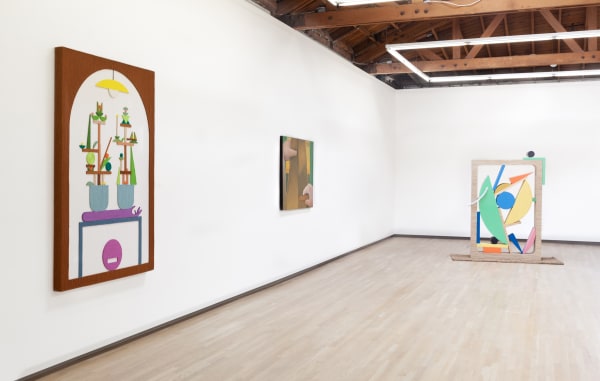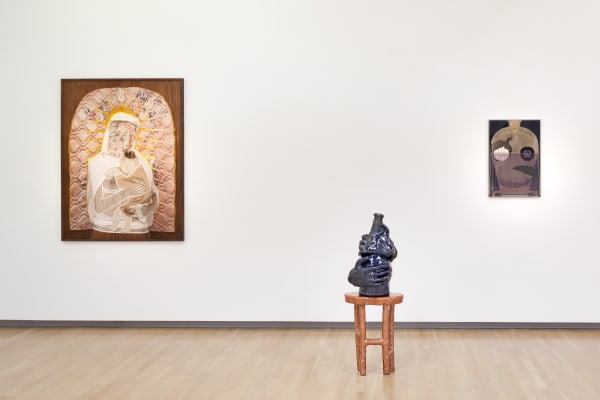Shulamit Nazarian is pleased to present Roommates, an exhibition of works by Chris Bogia, Woody De Othello, Rachel Granofsky, and Michael Stamm. These artists investigate the domestic space as a psychological, and at times psychedelic realm. Drawing from a variety of sources and forms that evoke a sense of home, these artists embed objects and environments with the peculiarities of living beings, illustrating our relationship to possessions that share our most intimate spaces. Like the dancing furniture in Disney’s Fantasia, subject and object wiggle back and forth with a magical realism. The home dweller melts into the sofa, while objects begin to take on a life of their own – all achieved through means similarly found in cartoon animation: flatness, movement, and artifice.
New York-based Chris Bogia employs visual strategies of arrangement and design often utilized by interior designers. Unbridled by a specific environment, Bogia’s work references the domestic interior without being confined to it – blurring the line between the decorative and the psychological. Throughout his practice, Bogia gives agency to anthropomorphized forms – complicating the utopic spaces he creates. Detached limbs squirm and gesture; both lazily reaching, and discreetly defiling, the carefully balanced interiors. Bogia’s sculptures suggest furniture and decor in both scale and material; he uses lacquer finishes, ornaments, and hand-laid yarn to subvert the expectations of craft. The modern comfort expressed in these works is precarious, suggesting that even personal utopias are fragile and easily disrupted. The ceramic sculptures of San Francisco-based Woody De Othello give life to the quotidian objects that make up our personal spaces. Often placed on top of stools, a variety of domestic items merge with fragments of the body, each endowed equally with a sense of life. His forms slumber and deflate – as if they could slip right off of their supports. During his childhood, Othello saw household objects as intimate presences, used to alter physical states. His ceramic works are hand-built through a process called slab construction, a technique that involves stacked panels of clay. Although the artist has a particular outcome in mind, his ceramics develop agency through their own creation – the weight of the clay ultimately dictates its shape, configuration, and personality. The resulting fired ceramics become unsettled objects frozen in an active state – well positioned to depict the psychological weight of human emotion. Rachel Granofsky’s photographs slow down the act of looking. She simulates digital post-production techniques by hand with materials such as tape, contact paper, and paint, inside her studio and home. The physical rendering of space calls attention to the conventions of image making found in commercial photography. As in painting, the treatment of the surfaces in her photographs are part of the subject matter, rather than just a means of creating illusionistic space. Objects are brought to life to create form in the domestic environment. In the photograph Ghost Sex the sense of body is implied through a mop, balloon, painted sweatshirt and jeans. The banality and detritus of her home amalgamate into the presence of two figures. Her interwoven layers conjure a domain, while at the same time obscuring the very physical objects that make her new environment possible. Drawing from design, literature, architecture, history, and autobiography, New York-based painter Michael Stamm probes the need for genuine human relationships in a world that is both increasingly interconnected and deeply alienating. Exploring themes of identity, physical and spiritual wellness, self-actualization and self-doubt, Stamm’s practice slyly counterbalances distanced, abstract contemplation and erratic, self-conscious confession. The artist’s paintings often depict domestic objects and environments, imbued with a sense of uncanniness that transcends and complicates simple representation. Through these works, Stamm critically considers the unspoken rules that structure everyday life, reconciling hope and skepticism in an era that require large doses of both.
-
 Rachel Granofsky, Ghost Sex, 2015
Rachel Granofsky, Ghost Sex, 2015 -
 Rachel Granofsky, Reno (Guts), 2016
Rachel Granofsky, Reno (Guts), 2016 -
 Chris BogiaArchway IV, 2019Yarn on wood71 x 48 inches
Chris BogiaArchway IV, 2019Yarn on wood71 x 48 inches -
 Chris Bogia, Bonsai (Temple Pine), 2019
Chris Bogia, Bonsai (Temple Pine), 2019 -
 Woody De OthelloWrapped Up, 2019Ceramic, glaze, carved wood25 x 20 x 15 inches
Woody De OthelloWrapped Up, 2019Ceramic, glaze, carved wood25 x 20 x 15 inches -
 Woody De OthelloDoing Well, 2017Ceramic, underglaze, glaze, paint and epoxy resin43 x 19 x 15 inches
Woody De OthelloDoing Well, 2017Ceramic, underglaze, glaze, paint and epoxy resin43 x 19 x 15 inches -
 Michael Stamm, Tincture #16 (Ambivert), 2019
Michael Stamm, Tincture #16 (Ambivert), 2019 -
 Michael Stamm, Tincture #14 (Gifts For My Elusive Host), 2019
Michael Stamm, Tincture #14 (Gifts For My Elusive Host), 2019
-

Michael Stamm, Chris Bogia, and Rachel Granofsky in Roommates, Shulamit Nazarian, Los Angeles
-

Chris Bogia and Michael Stamm in Roommates, Shulamit Nazarian, Los Angeles
-

Chris Bogia and Michael Stamm in Roommates, Shulamit Nazarian, Los Angeles
-

Chris Bogia and Michael Stamm in Roommates, Shulamit Nazarian, Los Angeles
-

Michael Stamm, Rachel Granofsky, and Woody De Othello in Roommates, Shulamit Nazarian, Los Angeles
-

Rachel Granofsky and Woody De Othello in Roommates, Shulamit Nazarian, Los Angeles
-

the seen: Roommates at shulamit nazarian
Celia Glastris, The Seen, August 1, 2019 -

Autre: Roommates at shulamit nazarian
Autre Magazine, August 1, 2019 This link opens in a new tab. -

Art&Cake: Roommates at shulamit nazarian
Lorraine Heitzman, Art & Cake, August 1, 2019














